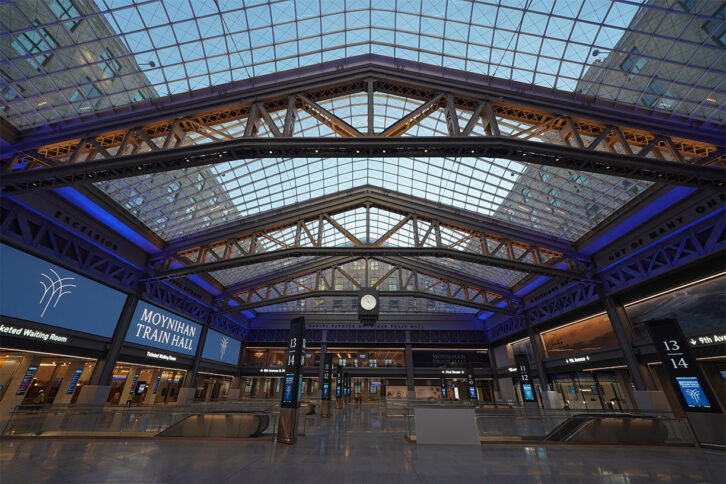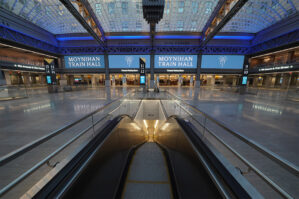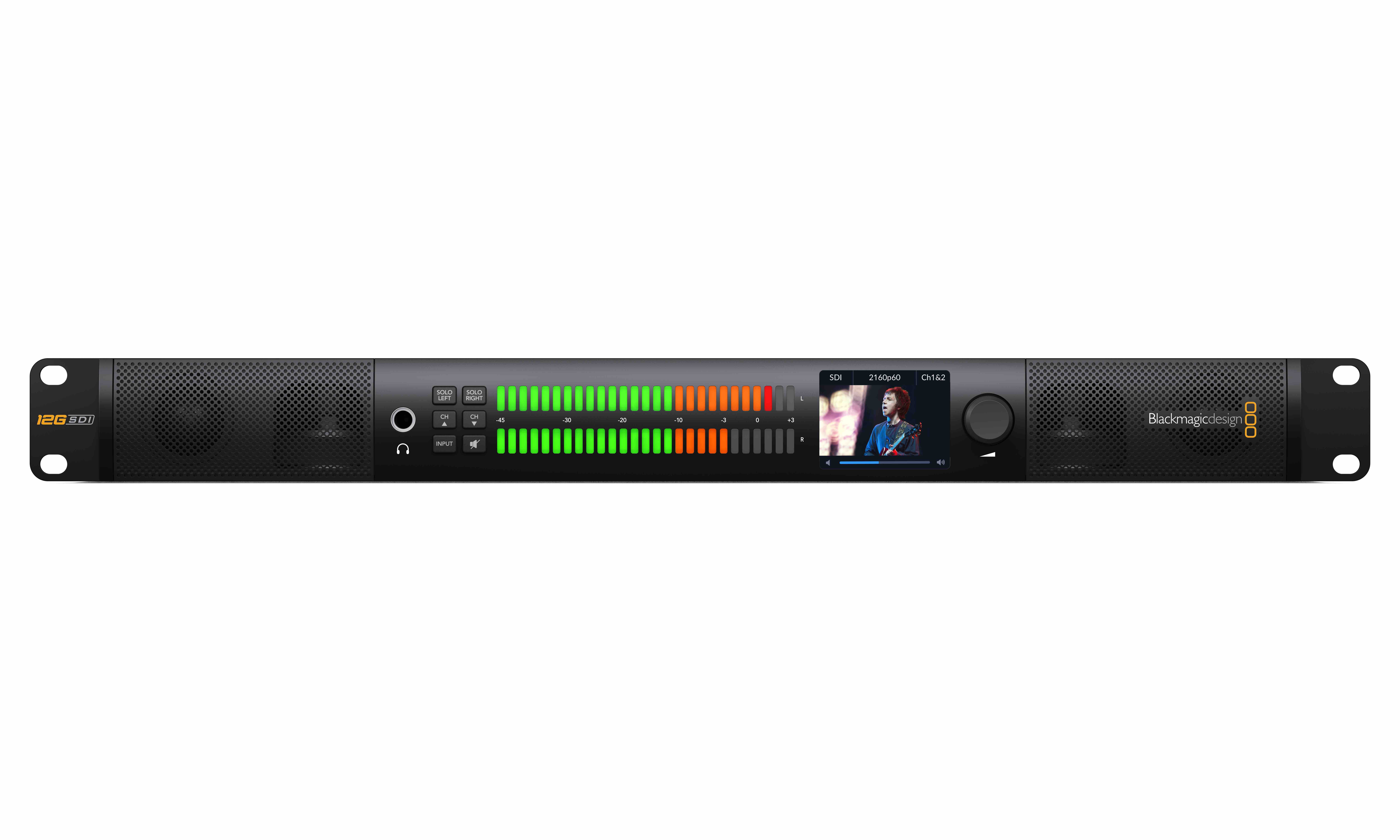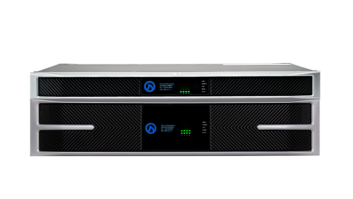
Moynihan Train Hall is an expansion of Pennsylvania (Penn) Station, New York City’s main intercity and commuter rail station. Built across 8th Avenue from Penn Station in the city’s former main post office building, the James A. Farley Building, the annex provides new access to most of Penn Station’s platforms for Amtrak and Long Island RailRoad passengers. Named after Senator Daniel Patrick Moynihan, the new 255,000 square foot (23,700 m2) hall provides ticketing, baggage, and customer service facilities, plus a large 320-seat customer waiting area for the thousands of daily passengers. AtlasIED technology was installed during the hall’s construction to deliver audio and emergency communications to employees and passengers.
The train hall, which opened in 2021 after a four-year construction project, was built to alleviate congestion in Penn Station. Penn Station and Moynihan Train Hall serve more than 700,000 passengers daily, making it the busiest transportation facility in the Western Hemisphere, serving more passengers than LaGuardia, John F. Kennedy, and Newark International Airports combined. The $1.6 billion renovation restored the Beaux-Arts Farley Building, a designated landmark, and added a central atrium with a glass roof. A remarkable feat of engineering and design, the station was selected as a finalist for the venerable 2021 Prix Versailles award in the passenger stations category.
Moynihan Station Development Corporation managed the construction project and wanted to ensure the former Farley Building’s structure retained its historical features. For the team of AV integrators tasked to install the mass communications and audio systems in the Hall, the building’s 92-foot-high stone and glass ceilings created multiple audio-related challenges.
Acoustical Modeling to Ensure Proper Audio Coverage
Acoustic and AV technology consulting company Cerami & Associates designed a system that would provide quality communications and audio intelligibility in a critical transportation environment. An essential requirement of the new train hall was meeting NFPA 72 audibility and intelligibility fire codes, which state a space must provide and maintain a sound pressure level of 15 decibels (dBA) above ambient sound levels for live or pre-recorded messages in public buildings.

Once Moynihan’s architectural designs were final, Justin Lau, an Associate Principal at Cerami, and his team acoustically modeled the train hall before construction began. Using software and the terminal’s architectural renderings, Cerami could test and refine audio acoustics and then recommend optimal loudspeaker placement for the space. From this testing, Cerami recommended the quantity, size, and spacing of loudspeakers to effectively cover what would eventually become a bustling, clamorous train station with thousands of people passing through daily.
“Moynihan Train Hall was an incredibly challenging space given the extreme ceiling height and the architectural features, including myriad reflective surfaces throughout the property,” said Lau. “Because we needed to meet specific building codes, including NFPA 72 standards, the acoustical modeling helped us uncover areas that could have otherwise suffered from poor coverage.”
Integrating CobraNet at Penn Station with Moynihan’s New Dante-based System
To operate a train station, train management — including ticketing, operations, and onsite security personnel — requires technology that enables them to communicate privately for routine operational purposes. Guest services and security personnel also need the ability to speak to station visitors via public address announcements, such as train arrival and departure times, platform changes, general safety information, or emergency communications when issues arise. One additional challenge the station presented was connecting a Dante-enabled AtlasIED GLOBALCOM communication system in the new train hall with a legacy CobraNet communications system in Penn Station. Brooklyn-based MKJ Communications, an AtlasIED-certified enterprise solution integrator (ESI) managed the installation and had previous experience with this dilemma during the LaGuardia airport renovation. MKJ chose a solution combining AtlasIED’s CobraNet-enabled and Dante-enabled audio-over-IP products to connect both buildings seamlessly and ensure operational effectiveness.
Delivering Mass Communications at Moynihan
The new Dante-based system at Moynihan is managed by an AtlasIED GLOBALCOM IP-116-D-CS Announcement Control System (ACS). The IP-116-D-CS is the heart of Moynihan’s mass communications system, managing the flow of announcements and messages between network endpoints such as digital communication stations, zone controllers, network power amplifiers, IP-based speakers and other types of IP endpoints throughout the train hall.
MKJ also chose the AtlasIED TitanONE T112 smart mainframe power amplifier to provide signal automation, processing, and amplification for the installed loudspeakers. When fully populated with amplifier cards, the T112 offers 12 main channels of amplification and two backup channels for redundancy. If an amplifier card fails, the digital signal processing switches automatically to the backup amplifier card.
Unlike airport terminals, train stations centralize paging and announcement systems in two main areas: the security center and the customer service center. Dante-enabled GLOBALCOM.IP Digital Microphone stations were installed in the main customer service center for initiating passenger-facing announcements with GLOBALCOM while the GLOBALCOM IED550CS-H digital touchscreen communications station was installed in the security center when security personnel needed to initiate announcements.
The loudspeakers represented one of the more challenging elements of the audio communications system installation because project leadership envisioned a clean, aesthetically pleasing appearance for the finished space with minimal AV intrusion. The loudspeakers had to blend seamlessly into the ceiling while providing high-intelligibility voice and signal reproduction throughout the train hall, including under the glass canopy. Additionally, the train hall houses retail and food vendors who often have their own background music that could compete with the main audio system. The AV team chose the FAP0T 4-inch in-ceiling loudspeakers and installed over 100 throughout the concourse to provide proper coverage based on Cerami’s findings during their acoustic modeling efforts.
“The Moynihan Train Hall project was truly one-of-a-kind, and MKJ is proud to have played a role in transforming space while maintaining the architectural qualities of the original building,” said John Massaro, Vice President at MKJ Communications. “The transformation of the Farley Building into a train station is one of modern history’s most impressive infrastructure renovation projects.”
Now complete, the spectacular Moynihan Train Hall is a space all New Yorkers can be proud of, as well as the teams and companies involved in the project to keep operations running smoothly and passengers safe and informed.










